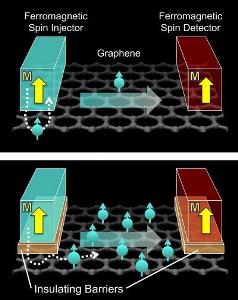Oct 15 2010
Physicists at the University of California, Riverside have taken an important step forward in developing a "spin computer" by successfully achieving "tunneling spin injection" into graphene.
An electron can be polarized to have a directional orientation, called "spin." This spin comes in two forms – electrons are said to be either "spin up" or "spin down" – and allows for more data storage than is possible with current electronics.
Spin computers, when developed, would utilize the electron's spin state to store and process vast amounts of information while using less energy, generating less heat and performing much faster than conventional computers in use today.
 Atomically-thin insulating barriers greatly improve spin injection into graphene. Top image shows flow of electrons (dotted line) when no insulator is used. Flow of electron spin polarization is greatly improved (bottom image) when a magnesium oxide insulator is used as shown.
Atomically-thin insulating barriers greatly improve spin injection into graphene. Top image shows flow of electrons (dotted line) when no insulator is used. Flow of electron spin polarization is greatly improved (bottom image) when a magnesium oxide insulator is used as shown.
Tunneling spin injection is a term used to describe conductivity through an insulator. Graphene, brought into the limelight by this year's Nobel Prize in physics, is a single-atom-thick sheet of carbon atoms arrayed in a honeycomb pattern. Extremely strong and flexible, it is a good conductor of electricity and capable of resisting heat.
"Graphene has among the best spin transport characteristics of any material at room temperature," explained Roland Kawakami, an associate professor of physics and astronomy, who led the research team, "which makes it a promising candidate for use in spin computers. But electrical spin injection from a ferromagnetic electrode into graphene is inefficient. An even greater concern is that the observed spin lifetimes are thousands of times shorter than expected theoretically. We would like longer spin lifetimes because the longer the lifetime, the more computational operations you can do."
To address these problems, in the lab Kawakami and colleagues inserted a nanometer-thick insulating layer, known as a "tunnel barrier," in between the ferromagnetic electrode and the graphene layer. They found that the spin injection efficiency increased dramatically.
"We found a 30-fold increase in the efficiency of how spins were being injected by quantum tunneling across the insulator and into graphene," Kawakami said. "Equally interesting is that the insulator was operating like a one-way valve, allowing electron flow in one direction – from the electrode to graphene – but not the other. The insulator helps to keep the injected spin inside the graphene, which is what leads to high spin injection efficiency. This counterintuitive result is the first demonstration of tunneling spin injection into graphene. We now have world record values for spin injection efficiency into graphene."
Study results appear this week in Physical Review Letters.
In their experiments, the Kawakami lab also made an unexpected discovery that explains short spin lifetimes of electrons in graphene that have been reported by other experimental researchers.
Kawakami explained that spin lifetimes are typically investigated through an experiment, known as a Hanle measurement, which uses a ferromagnetic spin detector to monitor the electron spins in graphene as they change direction in an external magnetic field. When his team placed a tunnel barrier in between the ferromagnetic spin detector and the graphene, the spin lifetime from the Hanle measurement jumped up to about 500 picoseconds (compared to typical values of 100 picoseconds) even though the researchers did nothing different to the graphene itself.
"People usually assume that the Hanle measurement accurately measures the spin lifetime, but this result shows that it severely underestimates the spin lifetime when the ferromagnet is touching the graphene," said Wei Han, the first author of the research paper and a graduate student in Kawakami's lab. "This is good news because it means the true spin lifetime in graphene must be longer than reported previously – potentially a lot longer."
Kawakami explained that, theoretically, graphene has the potential for extremely long spin lifetimes.
"This lifetime could be microseconds long," he said. "A long lifetime is a special property of graphene, making it a very attractive material for a spin computer."
Growing insulating barriers on graphene is neither a simple nor easy process. The insulator tends to form clumps on the graphene sheet, due in part to graphene's reluctance to form strong bonds with materials. To circumvent the problem of clumping, in their experiments the Kawakami team layered the graphene sheet with titanium (about half an atom thick) using a method called molecular beam epitaxy. The titanium layer, the researchers found, prevented the insulator from clumping on graphene or sliding off it.
Next in the research, the Kawakami lab plans to demonstrate a working spin logic device.
Source: http://www.ucr.edu/